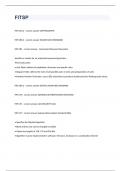Summary
Samenvatting (summary) - Strategic Management (TEWMBA)
- Course
- Institution
Strategic Management Summary, lecturer Peter Verhezen. Comprehensive notes from the lesson + exam questions that were covered in the lesson. Strategic Management Summary, Professor Peter Verhezen. Extensive notes from class + exam questions
[Show more]












